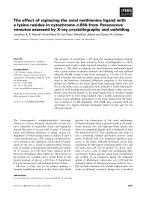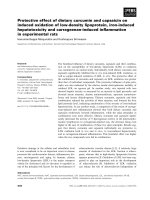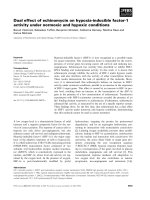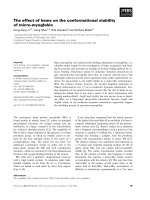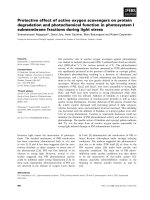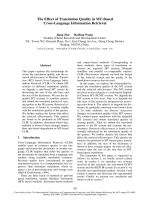Báo cáo khoa học: "Analgesic effect of caudal epidural ketamine in cattle" pps
Bạn đang xem bản rút gọn của tài liệu. Xem và tải ngay bản đầy đủ của tài liệu tại đây (46.06 KB, 4 trang )
-2851$/ 2)
9H W H U L Q D U \
6FLHQFH
J. Vet. Sci.
(2003),
/
4
(3), 261–264
Analgesic effect of caudal epidural ketamine in cattle
Inhyung Lee*, Tomo Yoshiuchi
1
, Norio Yamagishi
2
, Kenji Oboshi
2
, Yu Ayukawa,
Naoki Sasaki and Haruo Yamada
Department of Clinical Veterinary Science, Obihiro University of Agriculture and Veterinary Medicine,
Inada, Obihiro, Hokkaido 080-8555, Japan
1
Prevention of Epidemics Section, Kenou Animal Hygiene Service Center of Tochigi Prefecture,
Hiraide, Utsunomiya, Tochigi 321-0905, Japan
2
Research Center for Animal Hygiene and Food Safety, Obihiro University of Agriculture and Veterinary Medicine,
Inada, Obihiro, Hokkaido 080-8555, Japan
This study was performed to clarify the analgesic effect
of ketamine injected into the first intercoccygeal (Co1-
Co2) epidural space in standing cattle. Five adult cows
were randomly received 3 treatments at least 1 week
interval: 5, 10 and 20 mL of 5% ketamine. Sedation,
analgesia, ataxia and other effects on cardiopulmonary
and rumen functions were assessed before ketamine
administration and until 120 min. The analgesia without
sedation was shown at tail and perineum about 5 min
after all three treatments. The duration of analgesia was
significantly increased according to the volume of
ketamine (
p
< 0.01). There was a similar tendency of
ataxia with individual variation. There were minimal
effects on cardiopulmonary and rumen functions. The
present study showed that caudal epidural ketamine
administration induced analgesia without sedation in
cows, and the duration of analgesia was dose dependent
with ataxia. However, the duration of analgesia after 5
and 10 mL ketamine administration is short for common
surgical procedures and pain relief of perineum. Further
studies are needed to prolong the duration of analgesia
without side effects.
Key words:
caudal epidural anesthesia, ketamine, analgesia,
cattle
Introduction
Caudal epidural anesthesia is simple and inexpensive,
and requires no sophisticated equipment [22]. It is
routinely used in ruminants for obstetric manipulations,
caudal surgical procedures, and as an adjunct treatment for
control of rectal tenesmus [17]. Local anesthetics, such as
lidocaine, and
α
2
-adrenergic agonists, such as xylazine and
medetomidine, have been used independently [15,22], and
combinations of these drugs provide rapid onset and a
longer duration of analgesia [9,23]. Although many
experimental and clinical studies mainly focused on
analgesic effect of administered drugs [3-5,9,20,21,23],
there are side effects such as cardiopulmonary and ruminal
depression, and ataxia.
Ketamine, a potent noncompetitive antagonist at N-
methyl-D-aspartate (NMDA) receptors in the spinal cord,
has been used as a general anesthetic or analgesic in clinic
[1,11,16,24]. Gomez De Segura
et al
. [8] reported that
epidurally administered ketamine in the horse produces
local spinal and central nervous system effects with
analgesia and sedation but minimal cardiopulmonary
effects. To author’s knowledge, there are few studies that
have investigated the effects of ketamine after caudal
epidural administration in adult cattle. This study was
performed to clarify the analgesic effect of ketamine
injected into the first intercoccygeal (Co1-Co2) epidural
space in standing cattle.
Materials and Methods
The protocol and experimental design were approved by
the Obihiro University of Agriculture and Veterinary
Medicine Laboratory Animal Care and Use Committee.
Five 2- to 4-year-old Holstein cows (mean
±
SD, 3.2
±
0.8
years), weighing 478
±
60 kg with body condition score
(BCS) value 2.50
±
0.40 [7], were used in this study.
Cows were restrained in a chute. The skin area over the
first intercoccygeal (Co1-Co2) space was identified and
aseptically prepared [10,22]. Epidural puncture was
performed with an 18-gauge, 38 mm needle, that directed at
right angle to the general contour of the croup, and correct
needle placement in the epidural space was confirmed by
*Corresponding author
Phone: +81-155-49-5379; Fax: +81-155-49-5379
E-mail:
262 Inhyung Lee
et al.
hanging-drop method and noting no resistance during
solution injection [10,22]. Each cow randomly received 3
treatments at least 1 week interval: 5, 10 and 20 mL of 5%
ketamine hydrochloride (Ketalar, Sankyo Co., Tokyo,
Japan). The ketamine solution was administered at a rate of
0.5 mL/sec with the bevel directed cranially.
Sedation, analgesia and ataxia were assessed before
ketamine administration and at 5 min intervals until
60 min and at 15 min intervals thereafter until 120 min.
Sedation was defined when the upper eyelids drooped, the
degree of the head position against the shoulder and the
animal’s reduced awareness of its surroundings [15]. The
analgesia in the tail, perineum, hindlimbs and flank were
assessed by the responses to superficial and deep muscular
pinpricks. Ataxia was assessed by observing the hindlimb
position, swaying and leaning against the chute or any
knuckling of the fetlocks of the hindlimbs [4,15].
Heart rate (HR), respiratory rate (RR), mean arterial
pressure (MAP), rumen motility (RM) and rectal
temperature (RT) were assessed before ketamine
administration and at 15 min intervals thereafter until 120
min. A standard axis-base electrocardiogram (DynaScope
3400, Fukuda Denshi, Tokyo, Japan) was monitored
continuously to detect HR and arrhythmias during the
experiment. RR was determined by counting thorax and
abdominal excursions during 1 minute. MAP was
measured by placing a catheter with pressure transducer
(MK6030US Monitor kit, Baxter, Tokyo, Japan) in
auricular artery of ear. RM was evaluated by auscultation
of the left paralumbar fossa and determination of the rate
of ruminal contractions during 2 consecutive minutes. RT
was measured by electrical thermometer per rectum.
Descriptive statistics (mean
±
SD) was used, and one-
way ANOVA and Bonferroni/Dunn tests were utilized to
compare the time of onset and duration of analgesia (mean
of left and right sides) between the three groups. Values for
HR, RR, MAP, RM and RT were analyzed by using
repeated measures ANOVA. A value of
p
< 0.05 was
considered significant.
Results
There was no sedative effect in all three doses of
ketamine administration. The onset of analgesia was
almost similar in all three treatments (Table 1). The main
analgesic areas in 5 and 10 mL treatments were tail and
perineum, but analgesia of upper hindlimbs was shown
after 20 mL treatment. The duration of analgesia was
significantly increased according to the volume of
ketamine (
p
< 0.01) (Table 1). Ataxia was not observed
after 5 mL treatment, but four cows after 10 mL treatment
showed slight ataxia. After 20 mL treatment, all five cows
showed ataxia with individual variation. Ataxia of two
cows was slight and other two cows showed moderate, and
one cow was recumbent. There was no significant
difference in the onset and duration of ataxia (Table 1).
Although HR showed some significant changes after 10
and 20 mL administration (Table 2), these are within
normal ranges. RR, MAP, RM and RT did not show any
changes during experiments (Table 2).
Discussion
This study showed that caudal epidural ketamine
administration induced analgesia without sedation in cows,
and the area and duration of analgesia were dose
dependent like as in horses [8]. Although there were no
significant effects on cardiopulmonary and rumen
functions at any dose, ataxia was dose dependent.
Ketamine is known to have activity as a local analgesic,
and NMDA antagonist, an opioid agonist/antagonist and,
possibly, as an antimuscarinic [10,11]. Differences in the
analgesic response to epidurally administered ketamine
have been observed; attributable to anatomic differences,
dose regimen, and inhalation anesthesia [17]. These
complex actions and differences in analgesic response
have made the evaluation of epidural ketamine difficult
[10] and the epidural analgesic effect of ketamine remain
controversial [1].
Several factors may influence both the extent and the area
involved by epidurally administered drugs [18,22].
Especially intrinsic anatomic factors may play an important
role in determining epidural spread [13]. In preliminary
study, we examined the cranial distribution of new
methylene blue (NMB) solution injected into the Co1-Co2
epidural space in adult cows. Five mL NMB solution
administered to eight adult cows distributed until
lumbosacral region. This was greater than the common
number of dermatomes of bilateral analgesia after
administration of lidocaine [9] and ketamine in this study.
This means that there is a wider distribution of solution in
the epidural space than indicated by dermatomal analgesia
[12,13]. Because ketamine has similar pharmacologic
Table 1. Analgesic and ataxic effects of ketamine after caudal
epidural administration in cows (min)
Ketamine
(mL)
Analgesia Ataxia
Onset Duration Onset Duration
56.5± 2.2 17.0 ± 6.7
(n=5) (n=5) (n=5)
10 5.0 ± 0.0 34.0 ± 7.6* 6.3 ± 2.5 30.0 ± 23.8
(n=5) (n=5) (n=5) (n=4) (n=4)
20 5.0 ± 0.0 62.5 ± 8.7
†
11.0 ± 8.9 48.0 ± 17.9
(n=5) (n=5) (n=5) (n=5) (n=5)
*:
p
<0.01 versus 5 mL treatment group, †:
p
<0.0001 and
p
<0.001 versus
5 and 10 mL treatment group, respectively
Caudal epidural ketamine analgesia in cattle 263
characteristics with lidocaine [6] and the sciatic nerve is
consisted of the 6th lumbar, first and second sacral nerves,
there will be also possibility of ataxia if more larger solution
than 5 mL is administered as shown in this study. Also,
solution injected into the epidural space distributes along the
longitudinal epidural veins, which provide ideal conditions
for rapid vascular absorption [13]. Sedation after epidural
administration of xylazine is a typical sign of systemic
absorption through the epidural veins in cattle [14,20,21].
Although epidural ketamine of high dose (about 2 mg/kg)
caused only mild sedation in horses [8], cows of this study
did not show sedation. This effect may be explained by the
slow systemic absorption of ketamine from the epidural
space [19]. This may come from species difference, such as
the different caudal extent of the spinal cord within the
different epidural space, and difference of administration
method [8]. As a result of slow systemic absorption, there
were no large changes in HR, RR, MAP and RM, which
may reflect the concentration of ketamine in blood stream.
Production of caudal anesthesia depends upon the total
dose (volume
×
concentration) of the anesthetic
administered [22]. Recommended volume of solution for
caudal epidural anesthesia is 5 to 10 mL in adult cattle or
1 mL per 100 kg of body weight [10,22]. In this study, the
onset and area of analgesia after ketamine administration
was rapid and similar with that of lidocaine [9], but the
duration of analgesia was about a half of lidocaine [15].
However, if the similar volume (5-7 mL) was used with
xylazine, an
α
2
-adrenegic agonist, dermatomal analgesic
area could broaden, and surgeries of flank, udder and
scrotum could be performed in a standing position
[4,5,25]. Although it has been considered that ketamine
acts on NMDA-receptors of the spinal cord, the spinal cord
ends in the region of the last lumbar vertebra and the
meningeal sac is continued as far as the junction of the 3rd
and 4th sacral segments [10]. This difference is considered
as effect of pharmacokinetic of ketamine, lidocaine and
xylazine administered. Drugs that are either very
hydrophilic (i.e., lidocaine) or very hydrophobic (i.e.,
medetomidine) have permeability coefficients that are
significantly less than drugs of intermediate
hydrophobicity (i.e., xylazine or clonidine) [2]. If ketamine
has similar pharmacokinetic profile with lidocaine [6],
analgesic effect after caudal epidural administration may
be caused by similar mechanism with lidocaine. The
reason for relative short duration of analgesia after epidural
ketamine administration is not fully understood and more
detail studies of neuropharmacology are needed.
In a point of clinical view, epidural administration of 20
mL ketamine is not suitable for standing surgery of tail and
perineum because there is possibility of recumbency. The
duration of analgesia after epidural administration of 5 and
10 mL ketamine is short for common surgical procedures
and pain relief of perineum. However, it may be useful for
obstetric procedures such as dystocia because there are
minimal effects on cardiopulmonary and rumen functions.
It seems likely that neither racemic nor S(+) ketamine will
be clinically successful if used as sole therapy; only when
used in combination with other drugs and treatments can
secondary injury be effectively limited [11]. Further
studies are needed to determine whether the analgesia is
sufficient for surgery and whether the duration of analgesia
can be prolonged by the concurrent use of other epidural
drugs without systemic effects.
Table 2.
Cardiopulmonary and other effects of ketamine after caudal epidural administration in cows
Ketamine
(mL)
Time (min)
0 153045607590105120
HR 5 048 ± 10 049 ± 12 052 ± 11 047 ± 10 052 ± 10 051 ± 14 049 ± 10 051 ± 11 051 ± 12
(per min) 10 47 ± 8 050 ± 10 054 ± 3* 054 ± 12 052 ± 10 51 ± 550± 9 050 ± 10 51 ± 9
20 53 ± 8 056 ± 10 56 ± 8 057 ± 10 59 ± 8 061 ± 7* 060 ± 11 060 ± 13 057 ± 10
RR 5 032 ± 10 035 ± 11 034 ± 12 035 ± 11 30 ± 7 034 ± 12 35 ± 9 035 ± 11 035 ± 12
(per min) 10 30 ± 7 032 ± 11 035 ± 11 32 ± 5 034 ± 11 034 ± 11 032 ± 10 034 ± 10 032 ± 11
20 032 ± 17 035 ± 18 035 ± 18 035 ± 19 032 ± 17 032 ± 17 036 ± 20 034 ± 16 034 ± 16
MAP 5 108 ± 50 106 ± 20 105 ± 90 105 ± 60 105 ± 50 111 ± 80 106 ± 70 107 ± 80 108 ± 90
(mm Hg) 10 111 ± 12 109 ± 10 110 ± 17 108 ± 90 109 ± 13 121 ± 11 111 ± 13 107 ± 13 110 ± 11
20 120 ± 16 116 ± 11 112 ± 70 111 ± 13 108 ± 15 105 ± 13 112 ± 16 111 ± 10 111 ± 11
RM 5 03.2 ± 0.4 03.2 ± 0.4 03.4 ± 0.5 03.2 ± 0.4 03.8 ± 0.4 03.2 ± 0.4 03.2 ± 0.4 03.6 ± 0.5 03.0 ± 0.0
(per 2 min) 10 03.0 ± 0.0 03.2 ± 0.4 03.0 ± 0.0 03.2 ± 0.4 03.5 ± 0.5 03.0 ± 0.0 03.2 ± 0.4 03.0 ± 0.0 03.2 ± 0.4
20 03.0 ± 0.0 03.0 ± 0.0 03.0 ± 0.0 03.0 ± 0.0 03.0 ± 0.0 03.0 ± 0.0 03.0 ± 0.0 03.4 ± 0.5 03.4 ± 0.4
RT 5 38.9 ± 0.2 38.9 ± 0.1 38.8 ± 0.2 38.8 ± 0.2 38.8 ± 0.1 38.8 ± 0.2 38.8 ± 0.2 38.8 ± 0.1 38.7 ± 0.1
10 38.7 ± 0.3 38.8 ± 0.2 38.8 ± 0.2 38.7 ± 0.2 38.8 ± 0.3 38.8 ± 0.2 38.8 ± 0.2 38.7 ± 0.3 38.7 ± 0.3
20 38.9 ± 0.2 38.8 ± 0.2 38.8 ± 0.1 38.9 ± 0.1 38.8 ± 0.1 38.8 ± 0.2 38.8 ± 0.2 38.8 ± 0.2 38.8 ± 0.2
HR: heart rate, RR: respiratory rate, MAP: mean arterial pressure, RM: rumen motility, RT: rectal temperature. *:
p
<0.05 versus 0 value
264 Inhyung Lee
et al.
References
1. Beltrutti, D. P. C., Trompeo, A. C. and Santo, S. D. The
epidural and intrathecal administration of ketamine. Curr.
Rev. Pain 1999, 3, 458-472.
2. Bernards, C. M. and Hill, H. F. Physical and chemical
properties of drug molecules governing their diffusion
through the spinal meninges. Anesthesiology 1992, 77, 750-
756.
3. Caron, J. P. and LeBlanc, P. H. Caudal epidural analgesia in
cattle using xylazine. Can. J. Vet. Res. 1989, 53, 486-489.
4. Caulkett, N., Cribb, P. H. and Duke, T. Xylazine epidural
analgesia for cesarean section in cattle. Can. Vet. J. 1993, 34,
674-676.
5. Caulkett, N. A., Cribb, P. H., MacDonald, D. G., Fretz, P.
B. and Janzen, E. D. Xylazine hydrochloride epidural
analgesia: A method of providing sedation and analgesia to
facilitate castration of mature bulls. Comp. Contin. Educ.
Pract. Vet. 1993, 15, 1155-1159.
6. Dowdy, E. G., Kaya, K. and Gocho, Y. Some
pharmacologic similarities of ketamine, lidocaine, and
procaine. Anesth. Analg. 1973, 52, 839-842.
7. Ferguson, J. D., Galligan, D. T. and Thomsen, N. Principal
descriptors of body condition score in Holstein cows. J. Dairy
Sci. 1994, 77, 2695-2703.
8. Gomez De Segura, I. A., Rossi, R. D., Santos, M., San-
Roman, J. L. and Tendillo, F. J. Epidural injection of
ketamine for perineal analgesia in the horse. Vet. Anaesth.
Analg. 1998, 27, 384-391.
9. Grubb, T. L., Riebold, T. W., Crisman, R. O. and Lamb,
L. D. Comparison of lidocaine, xylazine, and lidocaine-
xylazine for caudal epidural analgesia in cattle. Vet. Anaesth.
Analg. 2002, 29, 64-68.
10. Hall, L. W., Clarke, K. W. and Trim, C. M. Veterinary
Anaesthesia. pp. 315-339. 10th ed. W. B. Saunders, London,
2001.
11. Kohrs, R. and Durieux, M. E. Ketamine: teaching on old
drug new tricks. Anesth. Analg. 1998, 87, 1186-1193.
12. Lansdowne, J. L., Kerr, C. L., Boure, L. P. and Pearce, S.
G. Development and evaluation of epidural anesthesia for
laparoscopy in foals (abstract). Vet. Surg. 2002, 31, 487-488.
13. Lee, I. H., Soehartono, R. H., Yamagishi, N., Taguchi, K.
and Yamada, H. Distribution of new methylene blue
injected into the dorsolumbar epidural space in cows. Vet.
Anaesth. Analg. 2001, 28, 140-145.
14. Lee, I., Yamagishi, N., Oboshi, K. and Yamada, H. Effect
of epidural fat on xylazine-induced dorsolumbar epidural
analgesia in cattle. Vet. J. 2003, 165, 330-332.
15. Lin, H., Trachte, E. A., Degraves, F. J., Rodgerson, D. H.,
Steiss, J. E. and Carson, R. L. Evaluation of analgesia
induced by epidural administration of medetomidine to cows.
Am. J. Vet. Res. 1998, 59, 162-167.
16. Martin, D. D., Tranquilli, W. J., Olson, W. A., Thurmon,
J. C. and Benson, G. J. Hemodynamic effects of epidural
ketamine in isoflurane-anesthetized dogs. Vet. Surg. 1997,
26, 505-509.
17. Muir, W. W., Hubbell, J. A. E., Skarda, R. T. and
Bednarski, R. M. Handbook of Veterinary Anesthesia, pp.
57-81. 3rd ed. Mosby, St. Louis, 2000.
18. Park, W. Y. Factors influencing distribution of local
anesthetics in the epidural space. Reg. Anesth. 1988, 13, 49-
57.
19. Pedraz, J. L., Calvo, M. B., Gascon, A. R., Hernandez, R.,
Muriel, C., Torres, L. M. and Dominguez-Gil, A.
Pharmacokinetics and distribution of ketamine after
extradural administration to dogs. Br. J. Anaesth. 1991, 67,
310-316.
20. Skarda, R. T., St. Jean, G. and Muir, W. W. Influence of
tolazoline on caudal epidural administration of xylazine in
cattle. Am. J. Vet. Res. 1990, 51, 556-560.
21. St. Jean, G., Skarda, R. T., Muir, W. W. and Hoffsis, G. F.
Caudal epidural analgesia induced by xylazine
administration in cows. Am. J. Vet. Res. 1990, 51, 1232-
1236.
22. Thurmon, J. C., Tranquilli, W. J. and Benson, G. J. Lumb
& Jones’ Veterinary Anesthesia, pp. 479-514. 3rd ed.
Williams & Wilkins, Baltimore, 1996.
23. Ting, S. T. L., Earley, B., Hughes, J. M. L. and Crowe, M.
A. Effect of ketoprofen, lidocaine local anesthesia, and
combined xylazine and lidocaine caudal epidural anesthesia
during castration of beef cattle on stress responses, immunity,
growth, and behavior. J. Anim. Sci. 2003, 81, 1281-1293.
24. Wagner, A. E., Walton, J. A., Hellyer, P. W., Gaynor, J. S.
and Mama, K. R. Use of low doses of ketamine
administered by constant rate infusion as an adjunct for
postoperative analgesia in dogs. J. Am. Vet. Med. Assoc.
2002, 221, 72-75.
25. Zaugg, J. L. and Nussbaum, M. Epidural injection of
xylazine: A new option for surgical analgesia of the bovine
abdomen and udder. Vet. Med. 1990, 85, 1043-1046.



